 Let’s talk about stones, and how much blood you can get out of them.
Let’s talk about stones, and how much blood you can get out of them.
It all started back on the Super Famicom with Shin Megami Tensei. The SMT series was, at its core, a JRPG about playing Pokémon while the forces of Order and Chaos battled for the very soul of humanity. It was philosophical. It was deep. It was banned in the West, because Satan may or may not have made an appearance. And it kicked off an entire franchise of titles based on the simple dichotomy of order and chaos and a general need for humanity to steer penis monsters riding chariots. SMT wound up a success for Atlus, which spawned a number of sequels and spin-offs, the most popular (eventually) being Jack Bros. Persona.
The Persona series started as, essentially, a slightly less apocalyptic version of SMT. Yes, there are demons, angels, and the occasional Hitler running around, but they’re all operating on the fringes of society, and not outwardly participating in the end of the world. It was basically the Harry Potter to Shin Megami Tensei’s Lord of the Rings. Many of the SMT trappings were still all over the titles, though, and no one was going to mistake Persona for an entirely independent franchise. Then we hit Persona 3, and things started to… mutate.
Persona 3 features demons, monsters, and a particularly homicidal version of Jungian psychology. It is also Day Planner: The Game. Persona 3 has frequently been referred to as “Japanese high school simulator”, but, even more than that, it is a game about balancing your (avatar’s) life. Do you go out tonight (and fight monsters), or do you stay home and study for that test tomorrow? Are you going to spend the afternoon hanging out with your girlfriend, or your best friend? 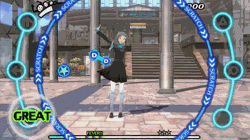 And would you like to spend time with the kindly old couple that is obsessed with a tree (?), or is it time to while away the afternoon playing a MMORPG where your homeroom teacher is inexplicably hitting on you? Decisions, decisions! Persona 3 isn’t only about choosing your battle tactics, it’s also about choosing your friends, afternoon plans, and how you combine trading cards into demons that may or may not summon the apocalypse.
And would you like to spend time with the kindly old couple that is obsessed with a tree (?), or is it time to while away the afternoon playing a MMORPG where your homeroom teacher is inexplicably hitting on you? Decisions, decisions! Persona 3 isn’t only about choosing your battle tactics, it’s also about choosing your friends, afternoon plans, and how you combine trading cards into demons that may or may not summon the apocalypse.
Persona 3 wound up becoming a pretty noteworthy hit. While there are a number of potential reasons for the success of the title, one significant factor is likely that you, the all-important player, so fully inhabit the life of this protagonist. In making practically every decision for this “hero” for one year of game life and about seventy hours of real life, it is rather inevitable that an audience would grow overly attached to their individually curated protagonist. And what happens the moment the main character is separated from the player? (Spoilers for a thirteen year old game incoming!) He dies! The protag literally cannot live without you!
The death of Persona 3’s hero is substantial for a number of reasons. The most obvious, of course, is how Persona 3 is all about death. Death, dealing with death, and the broad knowledge that one day you too will die are all general themes that pop up again and again in this title where you can also summon Thor to cast a lightning spell. But beyond that, there is the simple explanation that this is a focused, self-contained story that starts when a strange boy enters a strange city, and ends after that man has made meaningful relationships with people that will live on after his adventure and life have concluded. Persona 3, whether by thematic or simple writing convenience, is meant to be a wholly contained, limited story about the significant, last year of a teenager’s life. Persona 3 is not a story that is meant to go beyond its own borders. Persona 3 is a deliberately claustrophobic tale that is enhanced by its own limits.
And then, naturally, we had Persona 4. And it was a success. So we saw Persona 4 Super. And Persona 4: The Fighting Game. And Persona 4: The Fighting Game Turbo. And Persona 4: The Animation. And Persona 4: The Rhythm Game. By about the time we got to Persona 4: The Rogue-Like, a certain pattern had emerged: the enormously successful Persona 4 was, perhaps from its inception, built to be less a self-contained story, and more a franchise unto itself.
And then Persona 5 finally emerged. Persona 5’s fame may have peaked with this…
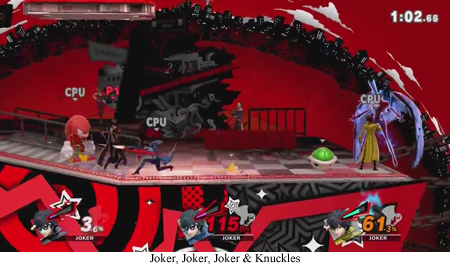
But we are also talking about a protagonist that practically launched alongside his own canon fursona…
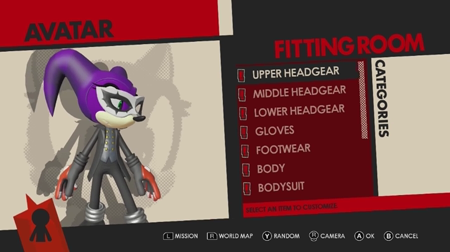
So it is pretty safe to say that Persona 5 was designed with a slightly different goal than the title that “started” the (most profitable version of the) franchise. Shin Megami Tensei gave way to SMT: Persona that gave way to a series that was simply known as Persona, and now it appears that individual Persona titles are attempting to be franchises unto themselves. Please look forward to Persona 5: The Shoot ‘Em Up.
And here’s Persona 5: The Rhythm Game right next to its simultaneous release of Persona 3: The Rhythm Game.
And, honestly? These twins seem to prove that both titles are equally lacking in meat on their respective bones.
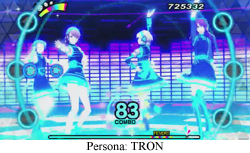 Let’s cover the good first: the soundtracks of both Persona 3 and Persona 5 are amazing, and an entire game based on their respective OSTs is incontrovertibly a good thing. Any excuse to listen to some of the iconic tracks from either series is a welcome pretext to press buttons along to the beat, and we’ve got an excellent GUI on our hands here, too. Some rhythm games can get a little confusing with their various “press this now” prompts, but there is no such screen muddling here. And you’re not expected to free-style for extra points, either. The game portion of Persona 3: Dancing in Moonlight and Persona 5: Dancing in Starlight is excellent, and a fine way to re-experience one of the best parts of both “origin” titles.
Let’s cover the good first: the soundtracks of both Persona 3 and Persona 5 are amazing, and an entire game based on their respective OSTs is incontrovertibly a good thing. Any excuse to listen to some of the iconic tracks from either series is a welcome pretext to press buttons along to the beat, and we’ve got an excellent GUI on our hands here, too. Some rhythm games can get a little confusing with their various “press this now” prompts, but there is no such screen muddling here. And you’re not expected to free-style for extra points, either. The game portion of Persona 3: Dancing in Moonlight and Persona 5: Dancing in Starlight is excellent, and a fine way to re-experience one of the best parts of both “origin” titles.
But it couldn’t just be a simple rhythm game. No, the Persona series seems to demand that every spin-off be somehow “canon”, so there is a full introductory scene that explains exactly why the casts of both games now must dance. It’s all a dream! Orchestrated by dueling sisters! There are no consequences for losing! There are no consequences for anything! But we’ll be damned if we let one Persona title pass without a novel’s worth of words that amount to absolutely nothing. It’s not nearly as egregious as Persona 4: Dancing All Night’s story mode (which, reminder, was an entire visual novel’s worth of dialogue and twists and turns that only amounted to “believe in yourself”), but, if you want to play the full game (and why wouldn’t you want the full experience available to you?), you must participate in “social link”-esque dialogues with various party members. Ever wanted to learn exactly what Mitsuru thinks about dancing? No? Well, too bad! It’s the only way to complete this escapade!
But the twin release of dance parties for Persona 3 and Persona 5 conveys a very telling tale: both supporting casts are boring as hell.
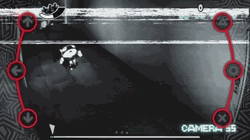 Okay, that might be a bit harsh. And, frankly, it even feels wrong. In the case of Persona 3, I finished the title, and immediately wanted to dive back into a New Game+ just to revisit all my old friends at Magical Dungeon High School. Similarly, Persona 5 had an unforgettable cast to the point that its fans could talk for hours about how some characters are violently underserved by their forced interactions with other (likely misogynistic) characters. In both cases, it seems like there’s a reason people would want to see the entire cast pop up again in new spin-off titles… or at least hang around in the background of a Smash stage. I liked Futaba! I could deal with more of her!
Okay, that might be a bit harsh. And, frankly, it even feels wrong. In the case of Persona 3, I finished the title, and immediately wanted to dive back into a New Game+ just to revisit all my old friends at Magical Dungeon High School. Similarly, Persona 5 had an unforgettable cast to the point that its fans could talk for hours about how some characters are violently underserved by their forced interactions with other (likely misogynistic) characters. In both cases, it seems like there’s a reason people would want to see the entire cast pop up again in new spin-off titles… or at least hang around in the background of a Smash stage. I liked Futaba! I could deal with more of her!
But the writing for this rhythm game (that may or may not simply be a way to further capitalize on an unforgettable soundtrack) truly underserves these casts. They are left as simple caricatures of themselves, and certain characters blend together across titles into one indistinguishable blob of archetypes (Ryuji and Junpei are the same guy, apparently). What’s the difference between the cold, calculating, but ultimately caring woman on Persona 3’s team and the cold, calculating, but ultimately caring woman on Persona 5’s team? Ostensibly, not much!
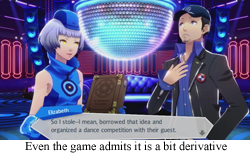 And this seems significant, as the cast of Persona 3 was only really meant for one (albeit long) adventure, while it is obvious that Persona 5 meant for its Phantom Thieves to go on and steal the show in other franchises and Persona byproducts. Joker is going to stop by Sonic World and the Mushroom Kingdom, but is he any more developed than Jack Frost? Persona 5: Dancing in Starlight seems to indicate that he’s not. He’s just as remarkable as the other cypher that didn’t even survive his maiden adventure.
And this seems significant, as the cast of Persona 3 was only really meant for one (albeit long) adventure, while it is obvious that Persona 5 meant for its Phantom Thieves to go on and steal the show in other franchises and Persona byproducts. Joker is going to stop by Sonic World and the Mushroom Kingdom, but is he any more developed than Jack Frost? Persona 5: Dancing in Starlight seems to indicate that he’s not. He’s just as remarkable as the other cypher that didn’t even survive his maiden adventure.
In the end, the support conversations of P5: Dancing with the Stars and P3: Dancing with the Doomed -the entire plot of both “adventures”- prove one thing: there isn’t much difference between Persona casts. And, considering one gang was meant for bigger and better things, that is rather demoralizing. Persona 5 was built to be the Big Mac to Persona 3’s Dollar Menu cheeseburger, but, once you’ve got your order, it turns out they’re both little more than a chicken nugget.
Just remember this moral when we hit Persona 5: Shin Arena Diving Space Tractor 2 Turbo. The Persona 5 well is already feeling a might dry…
FGC #440 Persona 3: Dancing in Moonlight & Persona 5: Dancing in Starlight
- System: Playstation 4 and… Playstation Vita? Really? Are you… sure?
- Number of players: I’ll be dancing with myself.
- Two Games? Let’s face it: the separation of these games into two different versions is a pretty obvious cash-grab. Persona fans are suckers, and pretty much every brand manager involved is well aware that those losers were always going to buy Persona: Dancing Red and Persona: Dancing Blue. And they’ll buy the special edition, too, because it comes with a plushie or something. And that plushie is still sitting on my desk as I type this. Damn fans.
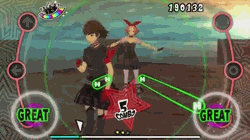 You’re complaining about the plot of a rhythm game? It’s not about the plot per se, it’s about that someone had the idea to make this a cool “hang out” game featuring both casts… and the “hanging out” seems less fun and more like a job required to earn a new hat. If I’m interpreting having a conversation with Ann as a boring slog now, I can’t imagine what’s going to happen in another seven spin-offs.
You’re complaining about the plot of a rhythm game? It’s not about the plot per se, it’s about that someone had the idea to make this a cool “hang out” game featuring both casts… and the “hanging out” seems less fun and more like a job required to earn a new hat. If I’m interpreting having a conversation with Ann as a boring slog now, I can’t imagine what’s going to happen in another seven spin-offs.- Favorite Track: Rivers in the Desert is severely underappreciated. Then again, Persona 5 has an amazing soundtrack all on its own, so there is some steep competition.
- Sexual Dimorphism is a Scourge: Most of the songs are accompanied by random characters bopping around to the rhythm, but two tracks per cast are dedicated music videos featuring either the boys or the girls. In general, one is kind of goofy and silly, and the other is sexy and sultry, complete with costumes and swimsuits. Want to guess which gender gets assigned to sexy times?
- Did you know? There’s probably a universe where someone decided to model all the social links for dancing, but Dr. Tae Takemi still refuses to get out of her chair.
- Would I play again: This (these?) title holds up as a great rhythm game, so I’m probably going to revisit some tracks in the near future. Unfortunately, I’m never going to touch the “plot” ever again. I have better things to do. And these Phantom Thieves should, too…
What’s next? Random ROB has chosen… Startropics 2: Zoda’s Revenge! Oh no! Zoda is gonna get his revenge! Please look forward to it!
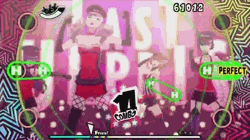
This is just… awkward.

I really miss the days when Persona was just Shin Megami Tensei with some school kids instead of a high school dating sim duct taped onto an RPG. I get a lot of people like that, but whenever we see a Persona 6 at the very least I would like to see something other than a fourth high school for the daily time sink.
Also I dread the day that the new era of Atlus decides to remake the original PSone Persona games with stuff like teacher love interests and (more) hand-firmly-down-pants anime antics and hot springs episodes and that one girl who gets added to all of Atlus’s remakes these days to make things far stupider with absurd retcons.
Hell, I miss 90s and early aughts Shin Megami Tensei. The old guard wouldn’t have let stuff like purging a Japanese ward of “invasive” inexplicably malevolent Chinese deities or beach episodes with spooging sea cucumbers fly.
On the featured games themselves, yeah it totally makes sense that games with such a killer soundtrack would have a rhythm game spinoff. Not the kinda spinoff I personally need or want a plot for, but it definitely makes sense.
Sure would be nice if Atlus would actually put Persona 3 its own dang self on PS4* though. This just reminds me of how bewildering it was to have a game celebrating Final Fantasy’s music on a platform where most of those games aren’t even available.
Like, I was never expecting Final Fantasy XIII to run on a 3DS, but Virtual Console rereleases of the SNES and/or Game Boy Advance games for the new 3DS or ports of the PlayStation games would’ve been nice, you know?
And the fact that the handheld can run (graphically compromised versions of) Snake Eater, Super Street Fighter IV, Dragon Quest VIII, Donkey Kong Country Returns, Yoshi’s Woolly World, Kirby’s Epic Yarn, Luigi’s Mansion, and (on new 3DS) Xenoblade Chronicles has me all the more disappointed that no crazy people at SE ever tried squeezing 10+10-2 or 12 into a 3DS card.
Oh well, at least the Switch is seeing good Final Fantasy port representation. Now if we could just get Atlus to put a REAL Persona on the Switch.
* And 4. And 4’s spinoffs I guess.
[…] a dungeon). We had just seen at least two releases of Persona 5 on other systems, and we even had that dancing game or the beat ‘em up to keep us company as vaguely new content. And then we have the Persona 4 […]
[…] So it is excellent that it follows the same beats… except that is terrible for a videogame. As has been noted on this blog before, as much as we all want in depth stories, some genres simply do not mesh well with “sit around […]
[…] it’s a great concept for inclusion in a rhythm game. The Hatsune Miku games of today (and games based off the same basic concept) have major problems with starting a featured song with 40 required inputs before you even have a […]